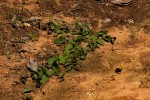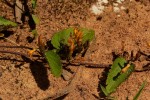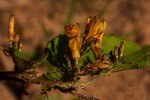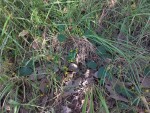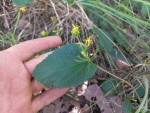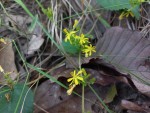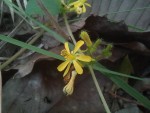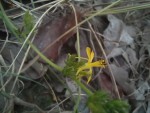Triumfetta glechomoides
Selected images: Click on each image to see a larger version and details of the record View all images (9)
Detailed records: Display species records QDS maps by: Google Maps Point records by Google Maps
Species details: Click on each item to see an explanation of that item (Note: opens a new window)
| Synonyms: | |
| Common names: | |
| Frequency: | |
| Status: | Native |
| Description: |
Prostrate perennial with a woody rootstock; stems up to 1 m long, stellate-hairy. Leaves more or less broadly ovate to almost circular, 3·5–7 cm long, cordate and 7–9-nerved at the base, sparingly hairy with simple appressed-setulose hairs above, scaberulous beneath with mostly stellate hairs; margin crenate-serrate; petiole up to 1·5 cm. long, stellate-hairy; stipules linear-lanceolate, up to 0·8 cm long, setulose. Inflorescences clustered at the nodes of the creeping stems or on erect flowering branches with reduced leaves up to 1·5 cm long; peduncles up to 5 mm long, sparsely pubescent; pedicels similar, 2–3 together, c. 5 mm long; bracts lanceolate, up to 2·5 mm long, setulose at least on the margins, together forming a small involucre. Sepals linear, c. 9 mm long, ciliate at the base, hairless in the middle, setulose with simple or bifurcate hairs in the upper half and usually with a single apical bristle. Petals yellow, obovate-oblong, almost as long as the sepals, ciliate at the base. Stamens 10, as long as the petals. Fruit 10 mm. in diameter including the aculei, pink, hairless; aculei short, 1·5 mm long usually with a single terminal seta or sometimes 2–3 setae. |
| Type location: |
Angola |
| Notes: | Easily distinguished by its prostrate habit and cordate leaves. |
| Derivation of specific name: | |
| Habitat: | Woodland and grassland, usually on sandy soils. |
| Altitude range: (metres) | |
| Flowering time: | |
| Worldwide distribution: | Angola, Malawi, Mozambique and Zambia. |
| FZ divisions: | N |
| Growth form(s): | |
| Endemic status: | |
| Red data list status: | |
| Insects associated with this species: | |
| Spot characters: | Display spot characters for this species |
| Images last updated: | Monday 2 March 2020 |
| Literature: |
Wild, H. (1963). Tiliaceae Flora Zambesiaca 2(1) Page 73. |
Other sources of information about Triumfetta glechomoides:
Our websites:
Flora of Malawi: Triumfetta glechomoidesFlora of Zambia: Triumfetta glechomoides
External websites:
African Plants: A Photo Guide (Senckenberg): Triumfetta glechomoidesAfrican Plant Database: Triumfetta glechomoides
BHL (Biodiversity Heritage Library): Triumfetta glechomoides
EOL (Encyclopedia of Life): Triumfetta glechomoides
GBIF (Global Biodiversity Information Facility): Triumfetta glechomoides
Google: Web - Images - Scholar
iNaturalist: Triumfetta glechomoides
IPNI (International Plant Names Index): Triumfetta glechomoides
JSTOR Plant Science: Triumfetta glechomoides
Mansfeld World Database of Agricultural and Horticultural Crops: Triumfetta glechomoides
Plants of the World Online: Triumfetta glechomoides
Tropicos: Triumfetta glechomoides
Wikipedia: Triumfetta glechomoides
